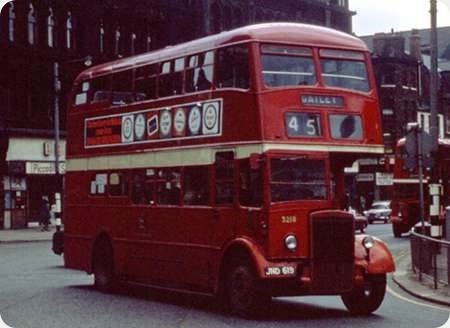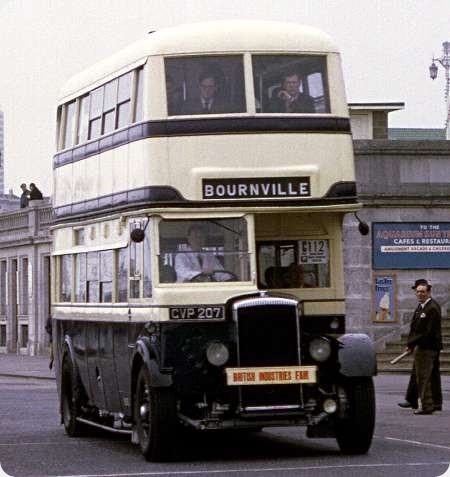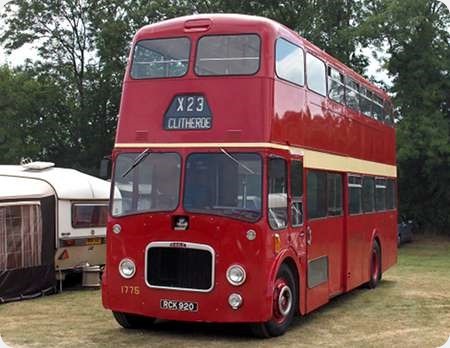
Manchester Corporation
1951
Leyland Titan PD2/3
Metro-Cammell H32/26R
Seen in Piccadilly in August 1969 in the final months of Manchester Corporation ownership is No 3218, JND 619, one of a batch of Leyland PD2/3 buses purchased in 1951. Despite appearances, the bodywork is not by Crossley, being instead of the then standard Manchester design built by Metro-Cammell. Having given some eighteen years of service to Manchester, this bus survived to pass into the SELNEC era, though not, I suspect, for long.
Photograph and Copy contributed by Roger Cox
23/07/18 – 06:58
This would be on a rush hour full service length extra on which these and the similar looking PD1/3s, which were withdrawn between 1967 and 1968, were regular performers. According to the official SELNEC fleet allocation these PD2/3s were not taken into stock, although Eyre and Heaps in the Manchester Bus have all but 3224, withdrawn in April 1969, transferred to SELNEC. What I suspect happened was that the vehicles were deemed withdrawn at midnight, MCTD having ceased at 23.59 on October 31 1969, SELNEC coming into being at 00.01 on November 1 – such are the legal niceties!
Further to my previous comments, the SELNEC operational fleet allocation on formation has 300 PD2s from Manchester and 103 from Salford in the Central Area fleet listing. No Manchester and Salford PD2s were allocated to other divisions on formation. The SELNEC stock allocation i.e vehicle assets taken over in whatever state, lists 501 PD2s in the Central area. Taking Eyre and Heaps listings in the Manchester Bus and in the Salford lists available, the number of PD2s owned by those undertakings on October 31 1969 was 387 in Manchester and 103 in Salford giving a total of 490. The situation would seem to have been that 67 PD2s from the MCW and Leyland bodied JND registered batch in the sequence 3200-3299 were transferred as assets but immediately deleted from the available fleet along with 1 from the Northern Counties batch 3300-3329 and 19 from the Leyland bodied batch 3330-3369. There is photographic evidence of one or more of these batches pressed into SELNEC service. There is however a discrepancy of 11 PD2s between the 501 listed as assets and the total of 403 operational and 87 midnight withdrawals. If anyone can find the missing 11, given that as far as I can ascertain, the assets of the Central division did not include any transfers in from elsewhere at the time of formation on November 1 1969 I would be grateful.
Phil Blinkhorn
24/07/18 – 07:25
I regularly travelled to and from school on these buses between 1964 and 1967. I understand that the shallower windows on each side at the rear were to support the platform which was not supported underneath as on most buses. I have read that Metro Cammell came up with this design, although Crossley adopted it as standard for a while.
Don McKeown
25/07/18 – 06:11
Manchester certainly got its moneys worth out of these buses and although quite elderly they were used on many lengthy prestige routes until the end of MCTD. They regularly appeared on the 17, 24 and 90 in Rochdale by which time the joint operating partners, Rochdale and Oldham on the 24 and 90 were using more modern stock. I always found them rather drab buses to travel in with lots of dark woodwork and a fairly depressing moquete pattern for the seats. And of course like most buses of that time the upper deck reeked of stale tobacco smoke. I think the experience of 1950’s upper deck travel so Mum could have a fag made me a life-long non-smoker!
Philip Halstead
26/07/18 – 06:45
I was living on Barlow Moor Road in Didsbury in 1969 and 1970, and I remember 3218 as being the only one of these at Parrs Wood garage – very much the odd one out; always slightly surprised when it turned up, which it often did on rush hour extras.
Steve Owen
27/07/18 – 06:45
I have slides of 3237, 3246 and 3255 taken in Manchester on October 29 1970. They did not sport the green SELNEC Central S.
They were showing the following route numbers 64X, 63X, and 62X respectively.
Stephen Bloomfield
29/07/18 – 07:36
Stephen, the Central flash was Blue.
Green was for the Southern Division, Magenta was the Northern Division, and the Orange was for the Coaches, Parcels, and Central activities. Brown was later used for the Cheshire Division, the ex North Western Road Car Company.
Stephen Howarth
05/08/18 – 07:52
I was using rush-hour limited-stop services along the Hyde Road corridorout of Chorlton Street bus station for a time between 1970 and ’71 and several of these "32xx" PD2s turned up regularly on routes such as the "124" and "207/208/209". The buses were run-down inside (torn-rexine) and were probably living outside the Hyde Road depot in the yard,awaiting the chop.
John Hardman
05/08/18 – 09:41
John, you are most likely correct in your assumption as to the source of the rush hour extras. SELNEC would have preferred not to have taken any vehicle assets over fifteen years old but the legislation demanded that the undertakings absorbed were absorbed lock, stock and barrel. The distinction that was made between the operational fleet and the total vehicle assets was quickly blurred due to the need to move vehicles around the divisions to introduce OMO and the need for extra vehicles caused by delays in deliveries. It would seem that the best runners from the withdrawn stock that still had valid certificates of fitness were temporarily relicensed to fill rush hour gaps. It was estimated that in 1965 one third of the Manchester fleet was retained for rush hour duties, generally vehicles over fifteen years old and apart from the 1953/1954 Daimlers which SELNEC took into the operational fleet, all those older vehicles in the Manchester fleet in 1969 were originally listed as non-operational. In passing it is worth commenting that the MCW PD2s outlived the newer Northern Counties bodied batch from 1953.
Phil Blinkhorn
07/08/18 – 06:06
I moved to Manchester to become a student in October 1970 and I am absolutely certain that MCTD 32xx series buses were in service then and at least for a few months afterwards. I do not recall seeing any 33xx series fleet numbers and I assumed that they had been withdrawn previously although at that stage of my university career I admit that I did not go far off the Oxford Road/Wilmslow Road axis.
Peter Cook
08/08/18 – 06:06
I became a Manchester student a year after Peter, and didn’t move far off the Oxford Road/Wilmslow Road axis either. My abiding memory is of the 1953/4 Daimlers on the 44/46. I do not remember the PD2s at all.
David Oldfield
09/08/18 – 07:21
Regarding Phil’s comment about a third of the Manchester fleet, I must admit I’ve always understood it to be the other way round – i.e. that Manchester’s peak problem was so severe that only one third of the fleet was out all day, with the majority being confined to rush-hour extras, rush-hour services, works services, works variants and works contracts. But I’ve believed that for so long now that I’ve no idea where I got it from.
Peter Williamson
10/08/18 – 07:12
Regarding Peter Williamson’s comments on the proportions of the Manchester fleet, the situation as he has it was certainly the case up until the late 1950s. From then things started to change. Rapidly increasing car ownership was the main factor but there were others. New vehicles delivered from 1957 had around 17% more seats than those they replaced and the eventual inclusion of reasonable numbers of Fleetlines and Atlanteans saw this figure rise to over a third more seats per bus. Diesel trains replacing steam on commuter lines and the electrification of lines to Crewe saw faster, cleaner and competitively cheap trains and the decimation of the Crossley fleet ahead of normal life expectancy were all factors which changed the the fleet use proportions. By 1969 the use of private cars had massively increased over that of 1960 and with far further large capacity vehicles in service, including the Mancunians, the need for a large rush hour fleet had diminished further.
Phil Blinkhorn
12/08/18 – 07:18
I’ve spent some time trying to reconcile the number of PD2s the SELNEC Central Division inherited and operated given the confusing numbers published in Eyre and Heaps The Manchester Bus, Manchester and Salford – One Hundred Years of Municipal Transport, Stewart Brown’s Greater Manchester Buses and my own sources from MCTD, Salford and SELNEC from 1968 through 1970. My own notes show that SELNEC intended to reduce its fleet of traditional front engined vehicles in short order and introduce OMO as soon as possible – an aspiration repeatedly delayed by late deliveries, the need to write down assets and union negotiations. It is a fact backed by written information from SELNEC, that SELNEC Central Division required an Operational Fleet for daytime running of 400 PD2s to cover services, maintenance, reserve vehicles for breakdowns and education departments’ needs. The Operational Fleet as far as PD2s were concerned was restricted to vehicles of less than 15 years old, in fact the oldest vehicles were the 1956 3400 series PND registered ex Manchester PD2s. Manchester contributed 300 PD2s, Salford 103. No vehicles to the best of my knowledge were imported to Central from other divisions. In addition to the Operational Fleet it appears Central had a fleet of licenced, driver training and withdrawn PD2s, all transferred from MCTD. The Manchester Bus in its vehicle listings at the back of the book infers the PD2s older than 15 years old that were transferred to SELNEC were fully licenced vehicles. Manchester and Salford a Century of Municipal Transport breaks down the transfer into driving school and withdrawn vehicles, as can be found on page 301 of The Manchester Bus, leading to the conclusion that the withdrawn vehicles were delicenced at midnight on 31 October/1 November 1969. However, the Eyre and Heaps publications disagree with each other in terms of numbers and because Manchester and Salford a Century of Municipal Transport was published much later than the last edition of The Manchester Bus, I have taken the latter’s figures. Central still required a reasonable number of rush hour extras and the older PD2s that were licenced, were thus employed. Most were withdrawn during 1970, the last of the pre 1956 PD2s in early 1971. The next discrepancy is that Greater Manchester Buses states that 501 PD2s were inherited in total and does not break down the numbers.
MCW Manchester Standard bodied PD2s 3200-3223 and 3225-3264 were transferred as licenced – total 64.
Leyland bodied PD2s 3287/94/99 transferred as licenced – total 3
3266/71/75/78/88/90 transferred as driving school – total 6
3265/67/69/70/72/77-79/82/89/92-95/97 transferred as withdrawn assets – total 15
Northern Counties bodied PD2s 3323 transferred as licenced – total 1
3324/25 transferred as driving school – total 2
Leyland bodied PD2s 3331/32/34/37/39/40/42/45-47/50-52/54/56-60/64 transferred as licenced – total 20
The overall PD2 assets transferred, if the later figures compared to the previous figures I had are to be believed number 514, now 13 more than noted in Greater Manchester Buses. Anyone else want to have a shot at sorting this?
Phil Blinkhorn
13/08/18 – 05:57
I’m surprised to read that there was a requirement specifically for 400 PD2s. What about the contemporary Daimler CVG6s (and CCG6s? Surely there would be some overlap between these two types?
Don McKeown
14/08/18 – 06:00
Unlike the situation with the PD2s, there was no cut off for Daimlers older than 15 years as the total of front engined Daimlers required for the Operational Fleet was 368 vehicles and to achieve this 48 CVG6s from Salford dating from between 1950 and 1952, 67 CVG6s from Manchester dating from 1950-1951 and all 110 of the 4400 batch of CVG6s and CVG5s from 1953 to 1955 were taken into all day service, though almost all of the 1950-1952 CVG6s from both city’s fleets had gone by the end of 1970, penny numbers of the Salford examples provided rush hour extras in early 1971. Again there are discrepancies in the published information. Greater Manchester Buses has it that 368 CVGs in total were taken by the Central Division but adding the requirement of 368 vehicles to the withdrawn and driving school assets taken over, the total is 407. the breakdown is as follows:-
Salford CVG6 415/16/18/25/28/29/33/39/57/61/63/65/70/73/78/83/84/85/88/98/506/07/11/21/22/24/25/27-29/31/33/35-41/43-45/47/48/52-54/60 Total 48 to Operational Fleet.
419/22/58/64/66/67/69/77/502/08-10/12/13/15/26/49/50 Total 18 taken over as withdrawn
Manchester CVG6/CVG5 4111/18/22-37/39-48/50-74/76-89/4400-4509 Total 177 to Operational Fleet
4101 Total 1 to driving school
4106-4108/4112-4116/19/21 Total 20 to driving school.
Post 1955 Daimlers CVG5 and CVG6s taken over were:
ex Salford 111-146/189-190 Total 38
ex Manchester 4510-4654 Total 105
It would seem the Greater Manchester Bus, unlike with the PD2s, only listed the number of CVGs in the Operational Fleet
Phil Blinkhorn



